The natural habitat of the Platte River and surrounding landscape was formed over millennia by natural forces including periodic floods, drought, fire, bison grazing, and other climatic factors. Once a braided river more than a mile wide, interlaced with sandbars and surrounded by a sea of grass – the Platte River we see today is highly altered from its historic condition. The Crane Trust seeks to maintain a glimpse of what was and the wildlife that depends on this system through adaptive habitat management.
Adaptive Management: Philosophy and History at the Crane Trust
The open mosaic of habitat along the Platte River was created from- and is dependent upon- natural disturbances such as bison grazing, periodic fire, drought, and flooding. These natural disturbances have been disrupted by human development and agriculture and the landscape has become fragmented. The Crane Trust uses periodic controlled burns, targeted interseeding of native plant species, tree clearing, targeted grazing, and sandbar clearing to manage lands on the Crane Trust’s lowland tallgrass prairie, wet meadow, cottonwood savanna, and braided river habitats. However, the historical frequency and timing of fires and floods and how those variables related to native grazers is not fully understood.
Different plant communities are promoted by differential burning and grazing times. For instance early season burning and grazing can control cool season exotic grasses. We use adaptive management to better understand the effectiveness of each treatment and use what we learn to direct future management decisions. We record ecological data before and after on permanent monitoring plots to understand the effectiveness of particular management actions in controlling woody encroachment, invasive species, and promoting plant and bird diversity. Our goal is to maximize native biodiversity, including at risk species such as the Henslow’s Sparrow, Regal Fritillary, Monarch Butterfly, Grasshopper Sparrow, Bobolink, Upland Sandpiper, and Greater Prairie Chicken, in addition to our other objective of managing for Whooping Crane and Sandhill Crane stopover habitat.
Prescribed Fire
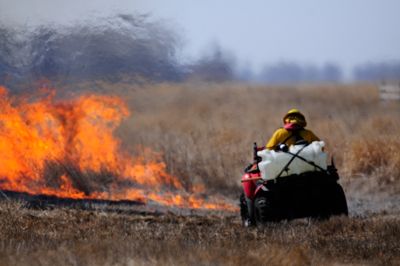
Fires once naturally burned across Platte River grasslands every 3 to 6 years. Their effect on the landscape was obvious, as trees were limited to isolated pockets and Platte River Islands. Today, the Crane Trust conducts prescribed fires throughout the year, but mainly during spring as a means of limiting encroachment by woody species, removing excessive litter accumulation, and maintaining grassland habitats for wildlife that rely on them. Fire is also used to promote diversity, which usually peaks 6-7 years after a fire in a tallgrass prairie system. Historically the Crane Trust was managed with a 3-5 year rotation consisting of burning, grazing, and then resting a pasture. Burns would included whole pastures and most burning was conducted in March to prevent highly invasive woody species from maturing and altering the structure and composition of tallgrass prairie ecosystems. However, fire at too high a frequency and over too large of an area has been shown to negatively impact some species of concern that need mature grasslands with heavy litter accumulation (Henslow’s Sparrow; Regal Fritillary). The same species that are negatively impacted by too frequent of fires are also negatively impacted by shrub encroachment from lack of fire. We are trying to be more dynamic to best manage for disturbance sensitive species in a disturbance dependent system (tallgrass prairie) by employing active adaptive management to understand complex management relationships such as these.
Discing
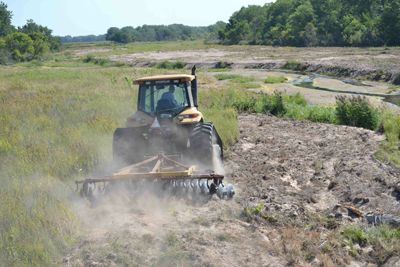
Periodic floods still happen along the Platte, but without the intensity, frequency, or effect that they once had. These scouring floods once erased vegetation from within the Platte’s channel and banks, providing roosting, feeding, and foraging habitat for a variety of migratory birds and local wildlife. As a way of keeping the river free of vegetation and necessary sediments on the move (yes, sandbars move downstream, very slowly), the Crane Trust tills vegetation up by discing and cutting overgrown islands and banks. This management is largely to thank for the habitat that remains today, allowing sandhill cranes and other waterfowl to seek the Platte in vast numbers each spring.
Grazing
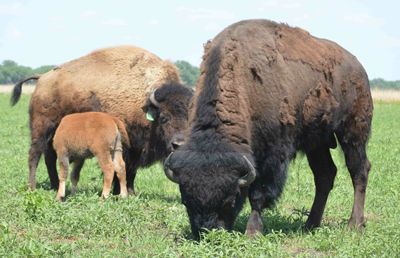
Like burning and floods, large herds of grazers once had an influencing force on the grasslands of the Platte River Valley. Today, the grass and the grazers are less common, but still exist. Cattle production relies on grassland forage, and cattle grazing closely resembles the affect that bison once had – they consume vegetation, disturb the soil surface, cycle new nutrients into the earth in the form of waste, and allow a variety of plants a chance at sunlight that thick grasses might otherwise overcrowd. However, bison grazing regimes would have moved in pulses and extended duration cattle grazing likely differs in character, intensity, and timing when compared to how bison would have naturally grazed. The Crane Trust is on the research forefront of using grazers to manage grasslands, and has recently reintroduced bison into the system as well. Studies are ongoing to determine how these two species impact vegetation and wildlife in different ways. We are experimenting with “pulse” grazing, by grazing only in the early spring and late fall to control exotic cool season grasses, while resting the pasture during the warm seasons (June through August). We have also been experimenting with patch burn/grazing in which grazers are concentrated on preferred forage created by recent burning, while resting the remainder of the pasture. This creates internal refugia for species that depend on thatch such as the larvae of overwintering Regal Fritillary butterflies and nesting Henslow’s Sparrows.
Spraying of Invasive Plants
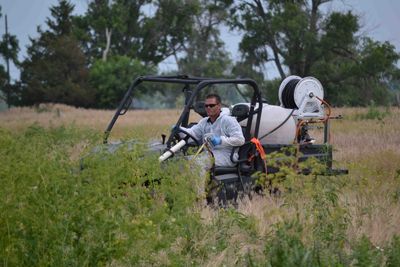
Chemical application is sometimes the only defense against non-native plant species capable of outcompeting native vegetation and permanently transforming Platte River habitat. In those cases, the Crane Trust uses aquatic-safe herbicides to keep bad plants in check. This tool also functions as a way of keeping sandpit islands free of vegetation for use by least terns and piping plovers.
